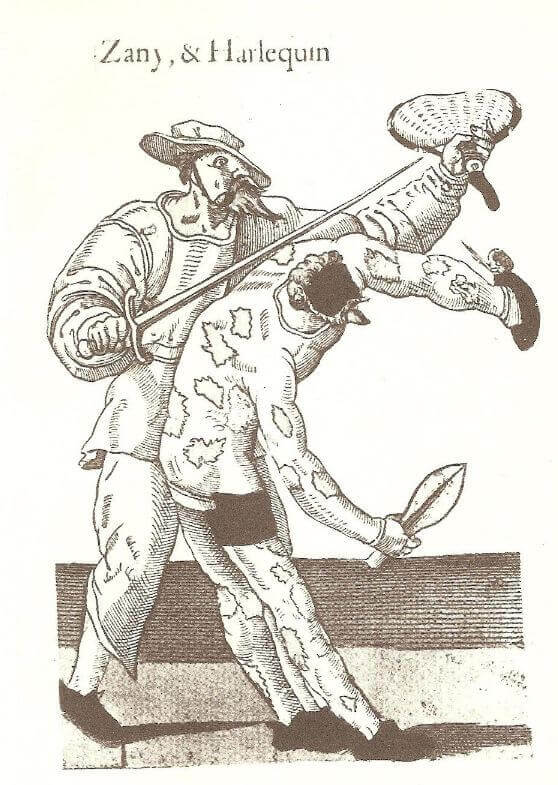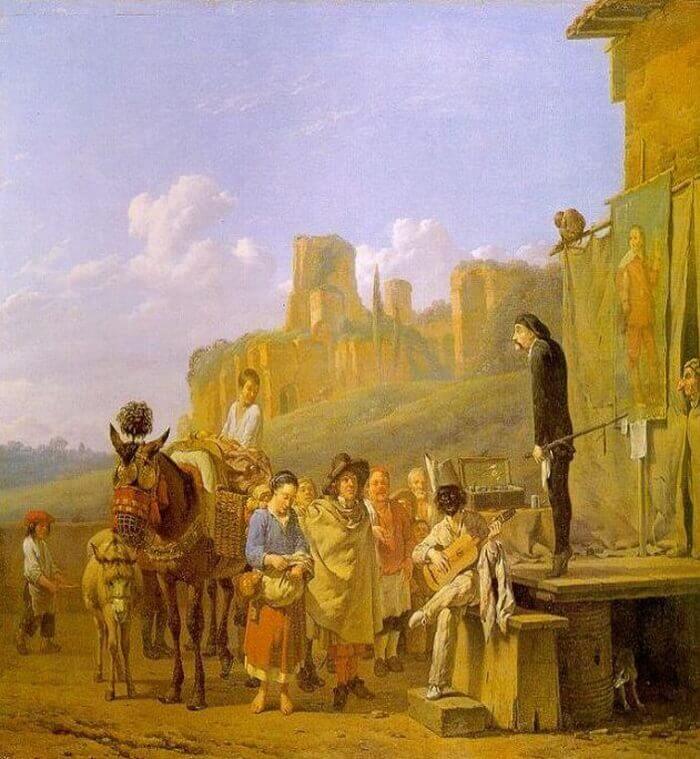
Zanni: an antique mask of the “Commedia dell’Arte”
Who Zanni was?
Zanni was a character of the comic theater of the ancient Rome later became mask of the Commedia dell’Arte. He represents the figure of the servant with coarse and instinctual ways of doing often related to sex and hunger. He has a custom that reminds the clothing used by the farmers during the works in the fields: a jacket knotted at the waist with a rope, beige baggy pants and a carefree cap similar to that used by the university students. On the left side he initially brought a man bag then a short stick. The mask is characterized by a long aquiline and curved nose. Zanni name had origin from Gianni: this name is very common in the Venetian-Lombardy countryside from where the majority of the servants of the nobles and of the rich Venetian merchants came from. The Commedia dell’Arte was also called “Commedia degli Zanni”, because the characters were easily identified with such servants farmers. Initially, Zanni was the servant of the Magnificent, an old, mean and lustful merchant who later took the name of Pantaloon: actual Venetian mask.
Curiosity about Zanni
- In the Trausnitz Castle in Bavaria, Germany, there are some famous well-preserved Zanni representations dating from 1576 to 1578:
– the frescoes by the Italian painter Alessandro Scalzi, where Zanni is represented in life-size, on the famous Narrentreppe staircase, the so-called staircase of the lunatics, buffoons and jugglers
– the miniatures with the grotesques of Antonio Ponzano on the ceiling of one of the majestic rooms.
- In England, he has given origin to zany word: an adjective which means “eccentric and fun”.
Our work in unique copy
Renovation of Zanni mask in white Bianco Carrara marble. Our passion for art and history has brought us to choose one of the most ancient masks of the Commedia dell’Arte. We have minimized the thickness of the marble in order to create an elegant and refined ornamental product. The manufacturing with traditional techniques and the polishing are handmade.
What does “Commedia dell’Arte” mean?
The Commedia dell’Arte is an artistic theatrical expression related to improvisation and masks. It was born in Italy in the sixteenth century and developed with the appearance of the first women on the stage until the mid-eighteenth century. Abroad it is called “Commedia Italiana”. In the Middle Ages, “art” meant profession; in fact in the companies recognized by the duchies and based on a statue of laws and rules, the actor job was considered a real work. It had origin from the jesters, acrobats and narrators performing in a comic and grotesque way with farces, sketches of daily life and popular stories. The improvised performances were held outdoor with few objects and people on the occasion of the festivities, of the markets and of the carnival. There were no written texts but simple scenarios where the basic elements, the play and a set list of the principal lines to adapt according to the kind of audience, were indicated. Carlo Goldoni, with his reform, took care, in the performance, of simplicity and rationality obliging to the use of the script and he eliminated the predictability of the lines, the vulgarity and the masks.
The masks of the Commedia dell’Arte animate even today the Carnival in Venice.

The Recueil Fossard is a collection of engravings of the Commedia dell’Arte, commissioned by Louis XIV to Fossard: a court musician and copyist. This collection represents various illustrations and advertising leaflets of the shows, where the different characters, with the stage directions in French language, are described.

First and second Zanni: two distinct characters
Zanni is a servant both clever and silly; on either version, he is funny and amusing. He creates misunderstandings with the master and he even tries to rise above his figure, coming immediately warned. The main characteristics are: to be hungry, to beg like a homeless and to continuously complain of his situation and of the various circumstances.
The two opposite character typologies:
– clever: he is an astute servant, agile and quick; he plays tricks to the master and to the others, but with the women he tries to have sex straight away. He has the gift of the gab, he gets very angry and often becomes aggressive and violent, also with the women.
– silly: he is a slow and ignorant servant, almost incapable to formulate a concept and he shows his slowness also in the movement that is impassive and curved downwards.
Over the years, the actors have specialized themselves in one of the two figures, having proper names in order to be distinguished during the comedy. Therefore they take the name of:
FIRST ZANNI: clever servants like the famous Brighella, Beltrame and Fratellino; they mark the history of the Commedia dell’Arte defining the rules and the roles of the characters and distinguishing the professional actors from the street performers.

SECOND ZANNI: silly servants like the famous Harlequin and Pulcinella. They become more famous than the First Zanni thanks to the ability of the actors and to the impact on the public. During the transition, Alberto Naselli known by his stage name Zan Ganassa was a very skilled zanni similar to Arlecchino and the first Italian artist who brought the Commedia dell’arte to Spain. In the mid-sixteenth century, Tristano Martinelli from Marcaria in the province of Mantua, a theater actor and acrobat, was instead the inventor of the actual Harlequin mask.
This article contains general information. For questions and curiosities leave a comment below. If you wish to be contacted, please fill out the form.





